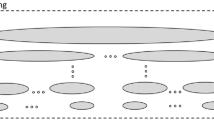Abstract
Our paper describes the requirements and possibilities of integration of metrics tools in the field of software quality assurance. Tools for the support of the measurement process are herein classified as Computer Assisted Software Measurement and Evaulation Tools (CAMETools). Software measurement regarded as a special type of metrics application provides a great amount of basic information for the evaluation of the software development process or the software product itself. Our paper examines the effectiveness and destination of software measurement in tool-based software development and is based on an analysis of more than 20 CAME tools in the Software Measurement Laboratory at the University of Magdeburg. CAMEtools are useable for the process, product, and resources evaluation in all phases of the software life cycle (including the problem definition) for different development paradigms. The efficiency of CAME tools is described on the basis of a general measurement framework. This framework includes all steps in the software measurement and evaulation process: metrics definition, selection of the evaluation criteria, tool-based modelling and measurement, value presentation and statistical analysis. The framework includes the main aspects of the process evaluation techniques (Capability Maturity Model, ISO 9000-3 etc.) and product evaluation (ISO 9126, etc.). It is not a disjointed set of aspects: our measurement framework represents an incremental technique for the application of quantification of quality aspects in a required quality assurance
Similar content being viewed by others
References
D. Garmus, D. Herron: Measuring the Software Process - A Practical Guide to Functional Measurements,(Prentice-Hall, 1996).
B. Henderson-Seller: Object-oriented Metrics - Measures of Complexity,(Prentice Hall 1996).
M. Shepperd: Foundations of Software Measurement,(Prentice Hall, 1995).
NASA: Software Measurement Guidebook (Maryland, 1995).
V.R. Basili, R.W. Selby, D.H. Hutchens: Experimentation in software engineering, IEEE Transactions on Software Engineering, 12(1986), 733–743.
P. Bourque, M. Maya, A. Abran: A sizing measure for adaptive maintenance work products, Proceedings of the IFPUG Spring Conference,Atlanta, 22-26 April, 1996.
R. Dumke, E. Foltin, R. Koeppe, A. Winkler: Measurement-based object-oriented software development of the software project "software Measurement Laboratory’. Preprint 1996, University of Magdeburg.
R.E. Prather: An axiomatic theory of software complexity measure, The Computer Journal, 27(1984) 340–347.
H. Zuse: Software Complexity - Measures and Methods (de Gruyter, Berlin, 1991).
H. Zuse: A Framework of Software Measurement,1997 (Forthcoming).
N. Fenton: Software Metrics - A Rigorous Approach (Chapman & Hall, 1991).
B.W. Boehm: Software Risk Management,(IEEE Computer Society Press, 1989).
C. Jones: Applied Software Measurement (McGraw-Hill, 1991).
H. Hausen: A rule-based approach to software quality engineering, in N. Fenton and B. Littlewood (eds), Software Reliability and Metrics,(Elsevier, 1991), pp. 48–68.
P. Jacob, T. Cahill: Software product metrics as attributes in an attribute grammar, Proceedings of the 21CSQ,October 1992, Research Triangle Park, USA, pp. 40–49.
B. Kitchenham, S.L. Pfleeger, N.E. Fenton: Towards a framework for software measurement validation, IEEE Transactions on Software Engineering, 21(1995) 929–944.
P. Coad, J. Nicola: Object-Oriented Programming,(Prentice Hall, 1993).
R. Dumke, A. Winkler: Object-oriented software measurement in an OOSE paradigm, Proceedings of the Spring IFPUG’96,7-9 February, Rome, Italy, 1996.
R. Dumke: CAME tools - lessons learned, Proceedings of the Fourth International Symposium on Assessment of Software Tools,22-24 May, Toronto, 1996, pp. 113–114.
R. Dumke, E. Foltin, R. Koeppe, A, Winkler: Software Quality with Metrics Tools,(in German) (Vieweg, 1996).
R. Dumke, K. Pinkert: Measurement and evaluation of LINUX components with the COSMOS measurement tool. SMLAB Report, 002/96.
R. Dumke, A. Winkler, F. Zbrog: Metrics in the hypertext and hypermedia software development (in German). Research Reports in Computer Science 1995-25, Technical University of Berlin, 1995, pp. 121–127.
R. Dumke, H. Zuse: Theory and Practice of Software Measurement (in German) (DUV, 1994).
H. Grigoleit: CAME tools - an overview. in: http://irb.cs.uni-magdeburg.de/se/metrics_eng.html
G. Kompf: Conception and implementation of a prolog measurement and evaluation tool (PMT) (in German), Diploma Thesis, University of Mageburg, July 1996.
C. Ruediger: A comparisonable analysis of the measurement facilities and quality of the metrics tools PC-Metric, Logiscope, Cosmos, and Qualms. Study, University of Magdeburg, October 1996.
C. Ebert, R. Dumke: Software Metrics in Practice (in German) (Springer, 1996).
R. Heckendorff: The Smalltalk Measure Browser. Study, University of Magdeburg, June 1996, 48 p.
A. Fix: Conception and implementation of a measurement data base for distributed use. Diploma Thesis, University of Magdeburg, July 1996.
Author information
Authors and Affiliations
Rights and permissions
About this article
Cite this article
Dumke, R.R., Grigoleit, H. Efficiency of CAMEtools in software quality assurance. Software Quality Journal 6, 157–169 (1997). https://doi.org/10.1023/A:1018507901618
Issue Date:
DOI: https://doi.org/10.1023/A:1018507901618




